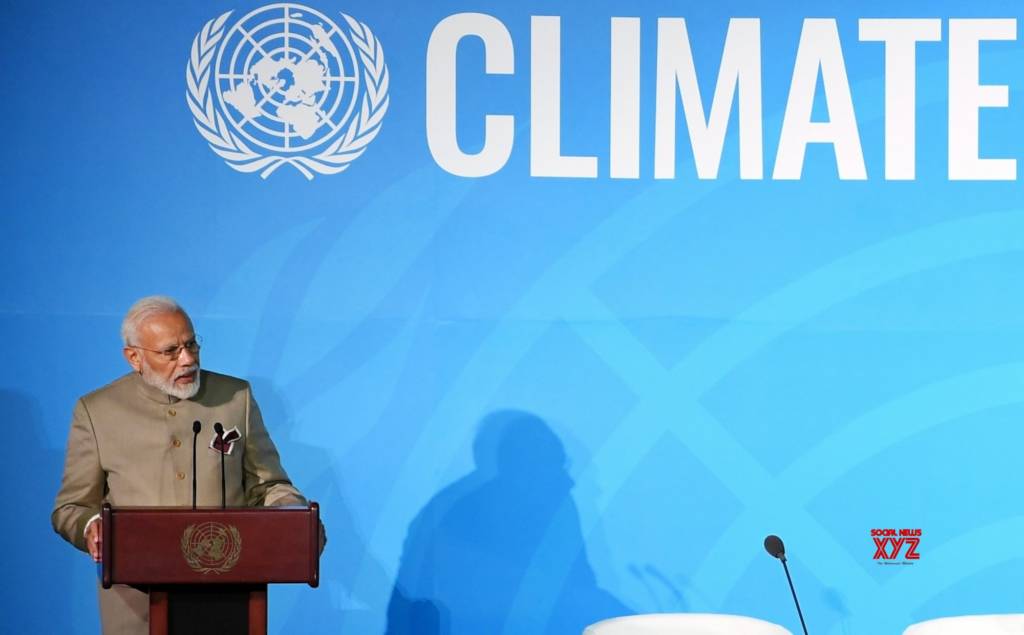At the United Nations Climate Action Summit, Prime Minister Narendra Modi asserted India’s commitment to move towards renewable energy as he pledged that India will increase its renewable energy capacity much beyond the target of 175 GW and take it further to 400 GW by 2022. While most of the developed countries are mere bystanders when it comes to climate change action and are still debating over the existence of global warming, India has quietly assumed the mantle of climate leadership and is setting mammoth targets towards climate change action, while working on its developing world aspirations. During this event, US President Donald Trump also made a surprise appearance and heard PM Modi and German Chancellor Angela Merkel’s speeches before leaving. Donald Trump and his administration has long avoided debate and even denied the existence of climate change issues, and even withdrew from the Paris Climate Accord.
India is a signatory to the Paris Agreement and like every other signatory, India had acknowledged a list of goals and pledged to achieve them by 2030 and had set itself a goal of achieving 40% of its electricity from non-fossil fuel sources by 2030. However, India is all set to achieve this goal by 2022 itself, a staggering eight years ahead of schedule. Moreover, Indian officials have estimated that the country might no longer need to build new coal plants beyond those that are already under construction. India has made some massive strides when it comes to solar energy with the Narendra Modi government betting big on it.
In a recent auction in India, developers of solar farms offered to sell electricity to the grid for 2.44 rupees per kilowatt-hour and India’s technological advances have emerged as a game-changer as the country managed to dramatically reduce the per-unit cost of power. That is about 50% less than what solar farms bid a year earlier and about 24% less than the average price for energy generated by coal-fired power plants. India’s commitment towards sustainable development and climate action was seen in Modi government’s move to gift each of the 193 UN Member States a solar panel with the solar panels also being installed at the roof of the United Nations Headquarters. The solar panels are valued about a million dollars and are powered up to reach the max of 50 KW of generation power. India has also partnered with the UN Secretariat to use renewable solar energy at the UN premises and the country has contributed nearly a million dollars to the solar project at the world body headquarters. India exercised its diplomatic clout when in collaboration with France, it launched the International Solar Alliance (ISA) which has emerged as a credible platform for ensuring universal energy access and energy equity.
The Prime Minister also announced that India is going to increase its renewable energy capacity beyond 175 GW from the present 80 GW by 2022 with the ultimate goal of reaching 450 GW shortly. India later revised its foal and aimed at reaching 225 GW by 2022 itself – a sign of India’s success in its relentless pursuit of moving towards a cleaner future. The government plans to spend $ 50 billion on the ambitious Jal Jeevan mission which focuses on rainwater harvesting, water conservation and development of water resources. India had a ministry for non-conventional energy sources since 1992, but things only picked up space after the Narendra Modi government took over in 2014 as the government extensively focused on sustainable growth which has resulted in the country’s renewable energy capacity registering a compound annual growth rate of over 20%. The Modi government’s focus on renewable sources of energy has certainly yielded results as India’s solar capacity currently stands at nearly 30 GW, up from 2.6 GW in 2014 and the in the same period, Wind capacity has shot up to over 36 GW from 21 GW.
The Indian Renewable Energy sector will also lead to the creation of millions of jobs and according to the International Labour Organisation, the sector is slated to create around 330,000 new jobs by 2022 and more than 24 million new jobs by 2030. The sustained focus on renewable energy will also reduce dependence on fossil fuels and thus India will be able to attain energy security. It is refreshing to see the Central government, with special focus of Prime minister Narendra Modi, combining sustainability with development and focusing on long-term goals which are the need of the hour.
